“Egarnae” and the Nasseau Connection
Much of the challenge in locating information about Jean deJarnat stems from the fact that there is no direct record that has yet been uncovered of which ship he may have been on. One theory has surfaced as plausible so far: Jean deJarnat is actually “Jean Egarnae,” a passenger who came over on the Nassau in 1701.
Above is the Rolle Des Francois, Suisses, Genevois, Alemans, Et Flamans, Embarques Dam Le Navire Nemmé Le Nasseau Pour Aller a La Virginie from the R.A. Brock text Documents, Chiefly Unpublished, Relating to the Huguenot Emigration to Virginia and to the Settlement at Manakin-Town, with an Appendix of Genealogies, Presenting Data of the Fontaine, Maury, Dupuy, Trabue, Marye, Chastain, Cocke, and Other Families.
This log contains a record of all French passengers on the British ship Nasseau, which arrived in Virginia in 1701. There is no immediate evidence that Jean deJarnat was on this ship. However a “Jean Egarnae,” traveling alone, is listed. The phonetic pronunciation of deJarnat, assuming one follows the rule of dropping the “t,” is remarkably close to Egarnae. There is additional evidence provided which points to this passenger as a potential match for Jean deJarnat:
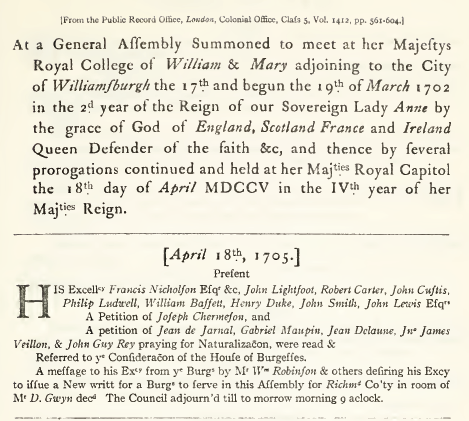
The above is a record of the original petition for naturalization by “Jean de Jarnal” and others which was made at William and Mary College in Williamsburg, April 18, 1705 found in the Legislative Journals of the Council of Colonial Virginia, Volume 1. Interesting to note is that Gabriel Maupin is also listed. A Gabriel Maupain, with his wife and three children, is listed as a passenger on the Nasseau.
As you can see, there are also challenges with the spelling of the surname. When I went to the Manakin Huguenot Society, I first encountered a book which listed “de Jarnal” as an alternate spelling for DeJarnette. I had never seen it before. Imagine my surprise when the copy of this naturalization petition surfaced with that exact spelling.
I admit I am limited here, since I have not yet seen the original petition to assess whether this was potentially written in error, nor have I seen the original of the Nasseau’s log. Both of these things are on my to-do list.
I will say that I found something very interesting as it related to the surname “de Jarnal” in some French records from the late 1600s, but I will save that for another post.
Sources
- Legislative Journals of the Council of Colonial Virginia. Edited by H. McIlwaine R. Vol. 1. Richmond: Colonial Press, Everett Waddey, 1918.
- Brock, R. A. “Rolle Des Francois, Suisses, Genevois, Alemans, Et Flamans, Embarques Dam Le Navire Nemmé Le Nasseau Pour Aller a La Virginie.” In Documents, Chiefly Unpublished, Relating to the Huguenot Emigration to Virginia and to the Settlement at Manakin-Town, with an Appendix of Genealogies, Presenting Data of the Fontaine, Maury, Dupuy, Trabue, Marye, Chastain, Cocke, and Other Families, 29-35. Baltimore: Genealogical Pub., 1962.
The Edict of Nantes and the Edict of Fontainebleau

“And not to leave any occasion of trouble and difference among our Subjects, we have permitted and do permit to those of the Reformed Religion, to live and dwell in all the Cities and places of this our Kingdom and Countreys under our obedience, without being inquired after, vexed, molested, or compelled to do any thing in Religion, contrary to their Conscience, nor by reason of the same be searched after in houses or places where they live, they comporting themselves in other things as is contained in this our present Edict or Statute.”
Article 6 of the Edict of Nantes codifies the peace between Protestants and Catholics in France after the Wars of Religion, which were a series of civil wars occurring from 1562 and lasting until the issuance of this Edict in 1598. Henry IV, a former Protestant himself, reinstated many measures which promoted pacification of both Protestants and Catholics with this Edict. These measures included a number of precursors to modern law: the right to exercise religion, freedom from harassment, protections against unwarranted seizure of property or persons, and similar articles which did not favor either religious group, but accorded to each some measure of autonomy in practice.
Click here for more excerpts from the Edict of Nantes.
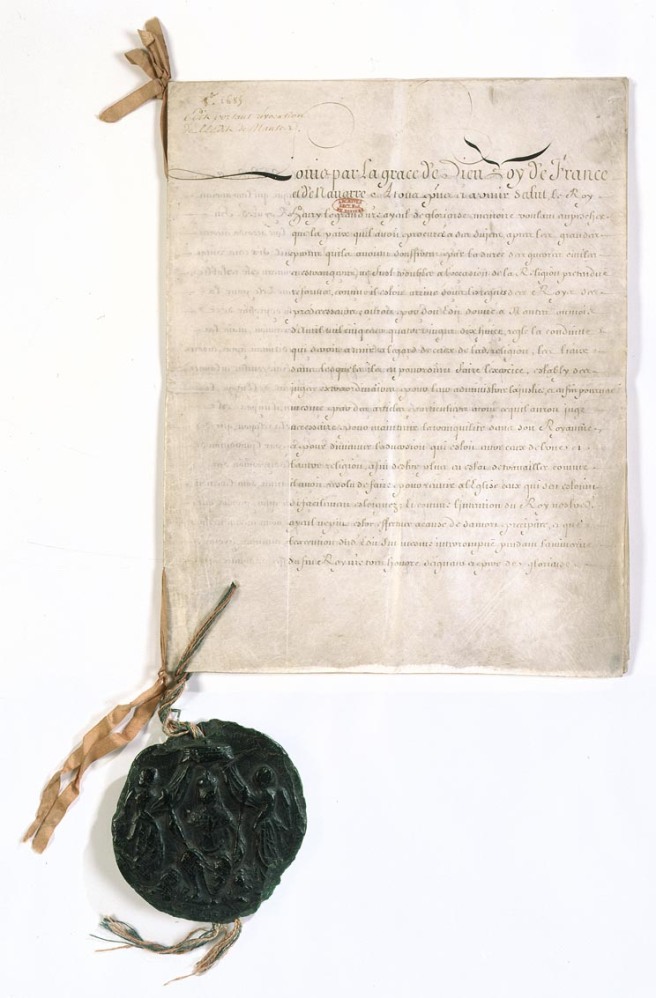
The Edict of Fontainebleau, also known as the Revocation of the Edict of Nantes, was issued by Louis XIV in order to eliminate the practice of the Protestant faith in France. It prohibited the exercise of the Protestant faith, “in any place or private house, under any pretext whatever excuse it can be.” Among other articles, it also forbade nobles from joining or practicing the Protestant faith, forced the expulsion of those who were unwilling to convert to Catholicism from France and dictated that all children born to Protestants were to be baptized as Catholics. Somewhere between 200,000 and 250,000 Huguenots left France in the late 17th century. While they mainly settled in Protestant European countries such as the Dutch Republic, Britain and Germany, some settled in South Africa and a few hundred left for the American Colonies.
Click here for a link to the full text of the Edict of Fontainebleau.
As you can see, we have wildly differing leadership between Henry IV and Louis XIV, who was Henry’s grandson. The Revocation was one of the main reasons that Huguenots left France. It’s likely that Jean de Jarnat was among these refugees.
On a somewhat related note, is anyone else watching Versailles? I know the first series/season is done in the UK, but we just started it here in the States. I’m interested to see how it stacks up to the historical realities of King Louis XIV’s court. So far, it seems interesting, even if it is drawing from the more sensational elements of the time period.
Sources
- Henry IV. “Edict of Nantes.” Edict of Nantes. Accessed September 27, 2016. http://www2.stetson.edu/~psteeves/classes/edictnantes.html.
- Henry IV. “Edit De Nantes Avril 1598.” Digital image. Wikimedia Commons. June 6, 2009. Accessed September 27, 2016. https://commons.wikimedia.org/wiki/File:Edit_de_Nantes_Avril_1598.jpg.
- Louis XIV. “Edict of Fontainebleau (October 22, 1685).” Internet Modern History Sourcebook. July 1998. Accessed October 2, 2016. http://huguenotsweb.free.fr/english/edict_1685.htm.
- Louis XIV. “The Edict of Fontainebleau, Revocation of the Edict of Nantes, 1685.” Digital image. Wikimedia Commons. August 13, 2010. Accessed October 2, 2016. https://commons.wikimedia.org/wiki/File:Revocation_of_the_Edict_of_Nantes.jpg.
- Murdoch, T. V. “Dispersion.” In The Quiet Conquest: The Huguenots 1685-1985, 51. London: Museum of London, 1985.
Protected: Exhibit One
A Visit to the Manakin Huguenot Society
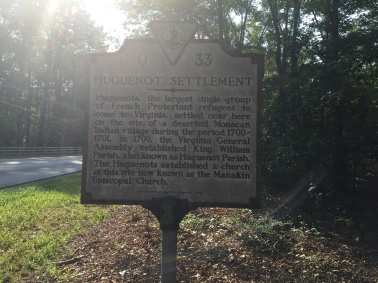
Yesterday I got up early to drive down to Manakin Episcopal Church in Midlothian, VA, for the service. I don’t consider church attendance a prerequisite for good research but I thought it might be interesting to spend some time in the area where one of the earliest Huguenot settlements was created.
Adjacent to the church is the building containing the meeting space and archives for the Manakin Huguenot Society, as well as the site of the Huguenot church. There is no evidence that Jean deJarnat was ever at the Manakintown settlement but the society has a number of resources and even allows membership for those who are descended from other French Protestant immigrants who arrived around the same time as the Manakintown settlers.
From the Manakin Huguenot Society‘s site:
Huguenots began coming to Virginia as early as 1620. In 1700-1701, five ships arrived at the mouth of the James River, then the York and the Rappahannock rivers, east of present-day Richmond, Virginia. French Huguenots, having fled religious persecution, had lived in England and Ireland and done military services for King William. They were granted lands in the New World for a permanent home where they had the freedom to worship as they pleased. West of Richmond, many founded a colony on the site of a village deserted by the Monacan Indians. This is a society of the descendants of that colony and French Protestants who came to Virginia before 1786…(1)
I had emailed the society’s librarian, Bryan, the week before and he had agreed to allow me
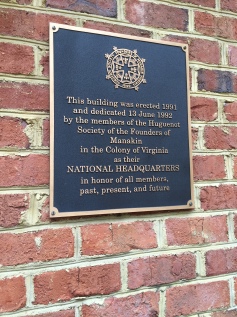
access to the archives after the service. Being the kind of person that sees a lot of detail in little things, I was very quickly overwhelmed by the amount of information contained in the archives. For myself, the most stressful thing about doing research is knowing what book, binder, or piece of paper to pick up. My instinct is to go through everything in the hopes that something pops out at me. In the interest of not being there forever, I picked a few things which I thought were most relevant to my current project.
Happily, and I say that in all seriousness, I came away with a lot more questions than answers. I am still in the process of organizing and documenting the information I have collected but I think we’ll see some interesting results when it’s all said and done. I’ve certainly found a number of starting points for further research.
On the site, this monument commemorates the first church built by the refugees:
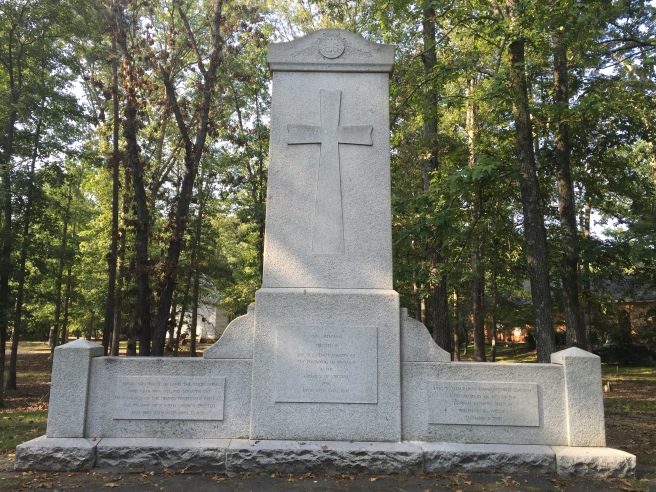

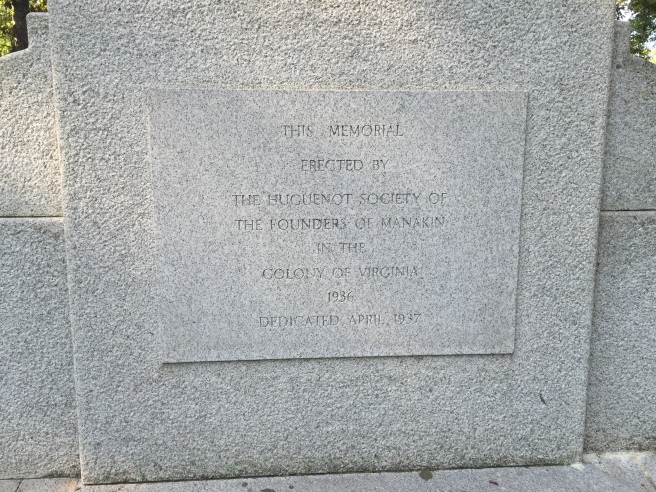
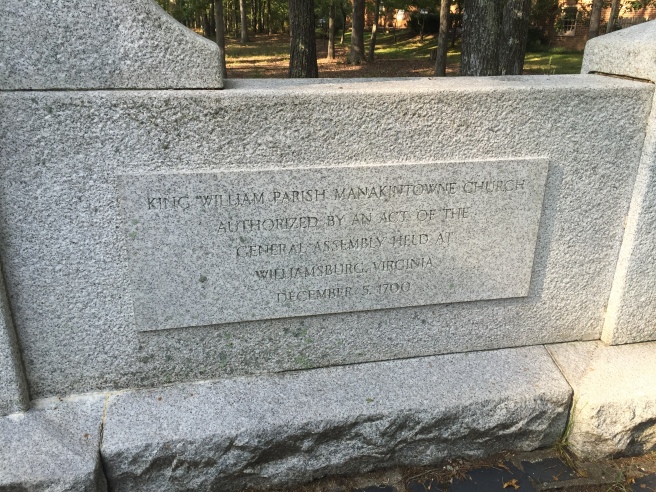
Crossing the James River as I drove to the church, I could almost imagine what it must have been like without the crisscross of roads and wires. I wonder if it seemed like a place that the Huguenots could call home. Did they see a future in Virginia or were they too concerned with survival to think about it?
Yesterday was September 11th, 2016, fifteen years after the terrorist attacks on the World Trade Center and Pentagon here in the US. Being in Virginia made me feel like I was looking into the past, seeing what the Huguenots saw through new eyes. I’ve not yet been to France but with the beautiful weather it made me wonder if the settlers recognized something of home in the landscape, or if what they recognized was perhaps the potential violence and terror of an uncertain life in a strange place: an unsettled future where their faith was the only thing they could rely on to keep them going.
Most interesting to me is the way in which myth making occurs when trying to reconstruct family history and history in general. As Napoleon said, “History is the version of past events that people have decided to agree upon.” There are sources which mention Jean or the deJarnat family but I am very much ready to take a closer look to see what, if anything, can be surmised with any measure of surety.
Sources.
-
“History of Virginia Huguenots and the Society.” Huguenot Society FMCV. Accessed September 12, 2016. http://huguenot-manakin.org/.
The St.Bartholomew’s Day Massacre
The entire day of Sunday, August 24, was spent killing, raping, and pillaging, such that the number killed on that day in Paris and the faubourgs is believed to be more than ten thousand persons, including lords, gentlemen, presiding magistrates and counselors [in the sovereign courts], lawyers, students, doctors, solicitors, merchants, artisans, women, girls, youths, and preachers. The streets were covered with dead bodies; the river tinted with blood; the doors and entrances to the king’s palace painted the same color. But the killers were not yet sated. (1)
This is an account of one of the bloodiest incidents that occurred during the conflicts between the Catholics and Protestants in France. On August 24, 1572, numerous unarmed Protestants had come to celebrate a royal wedding in Paris. Various events which occurred during the proceedings set off a massacre which took the lives of two to three thousand Protestants. The spread of violence to other towns killed what is believed to be another five to six thousand people. (2)
The following lecture given by Barbara Diefendorf at Boston University, Blood Wedding: The Saint Bartholomew’s Day Massacre in History and Memory, is an excellent introduction to this topic and explains the possible reasons for the outbreak of violence:
I agree with Diefendorf that we must not get bogged down in the religious aspect of these massacres. There are many and conflicting accounts of why and how this event occurred, and whether it was primarily personality conflicts among the nobility or popular religious fervor the importance of this massacre to the history of the Huguenots can’t be overstated.
Sources
- “The Wake-Up Call for the French and Their Neighbors.” In The St.Bartholomew’s Day Massacre: A Brief History with Documents, translated by Barbara B. Diefendorf, 113. Boston, MA: Bedford/St.Martin’s, 2009.
-
Diefendorf, Barbara B. The St. Bartholomew’s Day Massacre: A Brief History with Documents. Boston, MA: Bedford/St. Martins, 2009, 1.
-
Diefendorf, Barbara B. “Blood Wedding: The Saint Bartholomew’s Day Massacre in History and Memory.” Lecture, Boston University, Boston, MA, October 25, 2006. March 30, 2010. Accessed September 10, 2016. https://www.youtube.com/watch?v=5UIfXUoEKgo.
Who Were the Huguenots, Really?
It would be impossible for me to cover every historical detail about the Huguenots in one post, so I’ll give a bare bones overview and a chronology of events which we may need to round back to and expand upon at a later date.
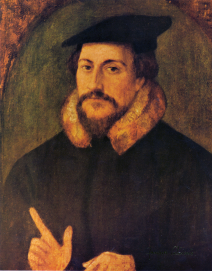
Huguenots are, generally speaking, any French Protestants who were persecuted for practicing their faith in 16th and 17th century France. (1) In 1519, German reformer Martin Luther’s doctrine of justification by faith and his ideas about emphasizing the importance of Scripture had reached Paris. The protestant belief system, aided by the popularity of French humanist philosophy, led to the spread of Calvinism among the population. Calvin’s belief was that Catholic masses were blasphemy since he saw communion not as a sacrifice but as a memorial service.
Many wealthier French nobles took to the Protestant faith and joined John Calvin in exile in Geneva. Robert J. Knecht, the author of Essential Histories: The French Religious Wars 1562-98, writes:
In the towns, Protestantism began appealing to the lower orders of society, particularly the artisans…Protestantism appealed to virtually all social strata and to a wide variety of occupations.
By 1559 we see an official gathering in Paris, considered the first Protestant national synod, where a ‘Confession of the Faith’ was endorsed. For those who are studying genealogy and are curious to know where the largest concentrations of Huguenots in France were, Knecht elaborates, “…the majority of Calvinist churches in France were south of the river Loire, in a broad sweep stretching from La Rochelle in the west to the foothills of the Alps in the east.” (2)
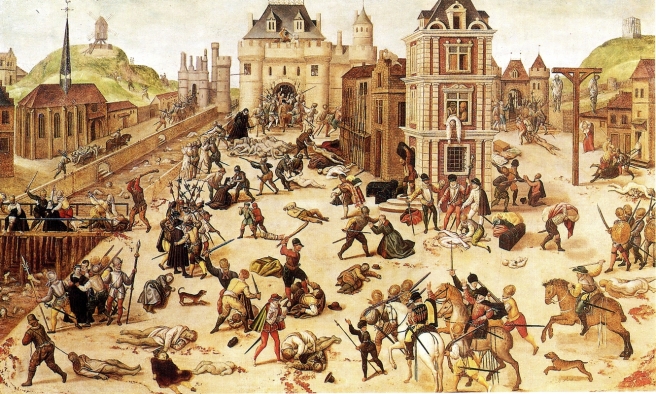
The most important question to ask is perhaps not how, but why the Protestant faith came into such bloody conflict with the Catholicism. The reasons are myriad, but I like Barbara Diefendorf’s explanation from her fantastically complex book Beneath the Cross: Catholics and Huguenots in Sixteenth-Century Paris:
We are used to viewing the wars of the early modern period as almost uniquely the affairs of princes and kings, but the religious wars were different. They had a resonance among the common people…They did not just affect people in material ways, in terms of higher taxes and devastated fields, but also appeared to threaten the very bases on which civil society was built…the doctrinal differences that separated Catholics and Huguenots were not perceived by the common people as abstruse scholarly debates but rather as crucial choices between truth and error…the religious war represented a crusade against heresy, a crusade that had to be won if civil society was to be preserved and salvation to be assured. (3)
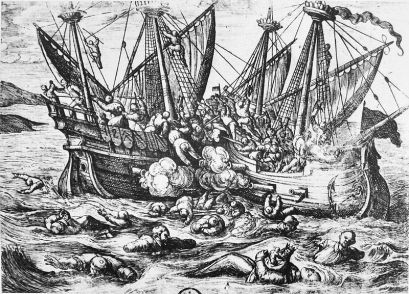
This was the world which Jean deJarnat and others like him were born into and subsequently expelled from. Further study is needed to determine what Jean was leaving from more than what he was coming towards. After leaving France, did he go straight to England? Did he join William of Orange’s army in the Netherlands?
The following is a chronology of events that would have influenced the emigration of the Huguenots, some of which we will cover in later posts:

While there may never be concrete answers, drawing reasonable conclusions from existing sources and creating a coherent narrative is certainly not outside the realm of possibility. That is exactly what I will attempt to do over the next few months.
Sources
1.Encyclopædia Britannica. Encyclopædia Britannica, 2016. s.v “Huguenot | French Protestant.” Accessed September 6, 2016. https://www.britannica.com/topic/Huguenot.
2.Knecht, Robert Jean. The French Religious Wars: 1562-1598. Oxford: Osprey, 2002, 15-16.
3.Diefendorf, Barbara B. Beneath the Cross: Catholics and Huguenots in Sixteenth-century Paris. New York: Oxford University Press, 1991, 178.
4.Ruymbeke, Bertrand Van, and Randy J. Sparks. Memory and Identity: The Huguenots in France and the Atlantic Diaspora. Columbia, SC: University of South Carolina Press, 2003, xv.
Jean deJarnat: A Huguenot Settler in Virginia
I have a very vivid memory of arriving to school one day when I was six or seven and being asked to spell my last name for the teacher. I would go: “D-E-capital J-A-R-N-E-T-T-E.” As always, whoever was on the receiving end of this would ask, “Is that French?” Being a child and not particularly interested in the details, I would usually shrug.
Despite being well-trained in making sure people capitalized the “J” it wasn’t until much later that I came to be interested in learning the history behind my last name. Driving through Virginia, one might see a number of signs for businesses and public spaces bearing the name, “DeJarnette.” My family, it seems, is a fairly prolific clan in that state.
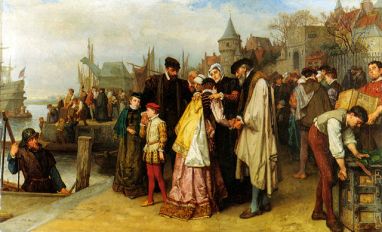
A while back, I was able to establish a genealogy that connects myself to the “ur” DeJarnette (then deJarnat), Jean. This site exists to further expound up his experiences as a French Protestant who settled in North America. As I gather more research, I will share it here and try to help put his life, and the lives of other early Huguenot settlers, into perspective.
By most accounts it is agreed that my 7th Great-Grandfather, Jean deJarnat, arrived in 1699 with a group of 600 French Protestant refugees sent by King William to Virginia. (1)

These French Protestant refugees were known as Huguenots and had been frequent targets for religious persecution by the Roman Catholic clergy. After the Revocation of the Edict of Nantes by Louis XIV in 1685, the Huguenots found this curtailing of religious freedom intolerable and emigrated in large numbers. More than 400,000 left France for the Netherlands, Prussia, or England. From England, many continued on to North America. (2)
It’s hard to say, after a point, which bits and pieces of family history are the most historically sound. Context clues tell us that Jean deJarnat was indeed what many people in my family claim he was. I will try to be as thorough and ethical in my explorations as possible and hope you will enjoy reading about the topics I will be sharing here!
Sources:
1.Frost, Earl C., and May M. Frost. DeJarnette and Allied Families in America (1699-1954). Redwood City, CA: Pacific Coast Publishers, 1954. Microform.
2.Encyclopædia Britannica. Encyclopædia Britannica, 2016. s.v “Huguenot | French Protestant.” Accessed September 4, 2016. https://www.britannica.com/topic/Huguenot.



